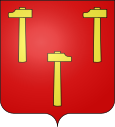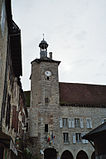Martel (Lot)
| Martel | ||
|---|---|---|

|
|
|
| region | Occitania | |
| Department | Lot | |
| Arrondissement | Gourdon | |
| Canton | Martel (main town) | |
| Community association | Causses et Vallée de la Dordogne | |
| Coordinates | 44 ° 56 ′ N , 1 ° 37 ′ E | |
| height | 92–336 m | |
| surface | 35.28 km 2 | |
| Residents | 1,597 (January 1, 2017) | |
| Population density | 45 inhabitants / km 2 | |
| Post Code | 46600 | |
| INSEE code | 46185 | |
| Website | http://www.martel.fr | |
 Martel - town view |
||
Martel ( Occitan : Martel ) is one of several villages ( hameaux existing) and individual farms in southern France municipality with a population of 1597 (status 1 January 2017) in the Lot in the region Okzitanien .
location
Martel is located about three kilometers north of the Dordogne in the historic province of Quercy . About 43 kilometers (driving distance) separate the place from Sarlat-la-Canéda in the west and about 35 kilometers from Brive-la-Gaillarde in the north .
history
In the tradition, the name of the village is often associated with Karl Martell, but there is no historical evidence for this. A Gallo-Roman settlement ( Uxellodunum ) was, however, identified and researched not far (near Vayrac and Saint-Denis-lès-Martel ). In the Middle Ages the place benefited from its location on the pilgrimage route to Rocamadour and possibly on to Santiago de Compostela . In the 13th century, Raimund IV , Vice Count of Turenne, granted the town a number of privileges (tax exemption, coinage). At the same time, Martel was a center of the judiciary - reportedly over 50 lawyers, judges and notaries worked here. In the Hundred Years' War Martel never occupied it, but in the Treaty of Brétigny delivered to the British (1360). Bertrand du Guesclin , however, recaptured the place for the French crown in 1374. During the religious conflicts and the Huguenot Wars (1562–1598), Martel - like the whole of Haut-Quercy - sided with the Catholics.
Population development
| year | 1962 | 1968 | 1975 | 1982 | 1990 | 1999 | 2007 | 2012 |
| Residents | 1,377 | 1,416 | 1,454 | 1,402 | 1,462 | 1,467 | 1,538 | 1,665 |
In the first half of the 19th century Martel had at times over 3,000 inhabitants; at the beginning of the 20th century there were still over 2,000. The mechanization of agriculture and the resulting loss of jobs resulted in a significant population decline.
Attractions

- Much of the townscape of Martel, the city of seven towers , still looks medieval.
- The Gothic fortified church of Saint-Maur (west facade 12th, nave 14th and tower 16th century) has a tympanum that is iconographically and stylistically in the footsteps of Beaulieu-sur-Dordogne . The church has been recognized as a monument historique since 1906 .
- The Saint-Pierre-ès-Liens de Gluges church is located in a cemetery below a rock wall ( abri ). The church building from the 12th and 15th centuries has been registered as a monument historique since 1913 .
- The Eglise de Louchapt from the 12th and 19th centuries has been registered as a Monument historique since 1990 .
- The Church of Murel was recognized as a Monument historique that same year .
- In Hôtel Fabri (. 12./14./16 century) died - according to tradition - Henry the Young King , son of Henry II. The building is a 1990 monument historique entered.
- The Palais de la Raymondie , the former city seat of the Counts of Turenne from the 14th century, has a mighty corner tower and arcades on the ground floor. Today it serves as the town hall ( Mairie ) and the Office de Tourisme . The building has been recognized as a monument historique since 1906 (with later additions) .
- In Maison Grise (. 12./16 century) lived formerly a come to prosperity family of lawyers - the judicis .
- The Hôtel Condamine (13th / 14th century) with two corner turrets was the former Martel mint.
- The Tour Mirandol (15th century) has a square floor plan and belongs to the Hôtel de Mirandol .
- The Hôtel Arcambal (16th century) is another Renaissance house with a representative portal. The building has been recognized as a monument historique since 1928 .
- The Grenier d'Abondance (16th century) is a beautiful Renaissance house.
- The cloister of a former monastery from the 16th century has also been recognized as a monument historique .
- The market hall (late 18th century) stands on the site of a meeting house from the pre-revolutionary feudal period. It has a huge roof made of chestnut wood that only rests on the outer stone pillars. On some of the pillars there are incised measurements for bread and grain. The floor consists of pebbles the size of a fist. The market hall has been recognized as a monument historique since 2004 .
- In the Musée d'Uxellodunum you can see prehistoric and Gallo-Roman finds. A collection of apothecary vessels (17th / 18th century) is also on display.
- In the ruins of La Vassaudie , located just outside the city , the origins of which are still a mystery, you can still guess the remains of a hall and a chapel with a Gothic ribbed vault.
economy
Martel was and still is a center of the truffle trade . In 1904 over 20 tons of this expensive edible mushroom were sold here. Today - according to official information - there are significantly fewer, but a lot is offered on the black market.
Community partnerships
Martel's partner municipalities are the Belgian municipality of Nassogne in Wallonia (since 1967) and the Mexican city of Tequila (since 2002).
Personalities
- Henry the Younger (1155–1183), King of England, died in Martel.
- Charles Ribeyrolles (1812–1860), French writer, was born near Martel.
- Henri-Marie Arlet, Bishop of Angoulême 1907–1933 , was born in Martel.
- Michele Causse, 1936–2010, was born in Martel.
literature
- Thorsten Droste : Périgord. Dordogne and Quercy - The landscapes in the heart of south-west France. DuMont, Cologne 1997, ISBN 3-7701-4003-6 , pp. 101-102.
Web links
- Martel, La Vassaudie - sketch + info (French)
Individual evidence
- ↑ Église Saint-Maur, Martel in the Base Mérimée of the French Ministry of Culture (French)
- ↑ Église Saint-Pierre-ès-Liens de Gluges, Martel in the Base Mérimée of the French Ministry of Culture (French)
- ↑ Eglise de Louchapt, Martel in the Base Mérimée of the French Ministry of Culture (French)
- ↑ Église de Murel, Martel in the Base Mérimée of the French Ministry of Culture (French)
- ↑ Hôtel Fabri, Martel in the Base Mérimée of the French Ministry of Culture (French)
- ↑ Hôtel de Ville, Martel in the Base Mérimée of the French Ministry of Culture (French)
- ^ Hôtel Arcambal, Martel in the Base Mérimée of the French Ministry of Culture (French)
- ↑ Cloître des Mirepoises, Martel in the Base Mérimée of the French Ministry of Culture (French)
- ^ Halle, Martel in the Base Mérimée of the French Ministry of Culture (French)
- ^ Nassogne website
- ↑ Comité de jumelage Tequila-Martel






